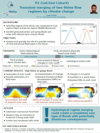PhD-Project P2 by Erwin Rottler (UP):
Transient merging of two Rhine flow regimes from climate change
Timescale: Nov. 2017 – Jan. 2021
Supervisors:
Prof. Dr. Axel Bronstert, University of Potsdam
Dr. Gerd Bürger, University of Potsdam
Background
The impact of a warming climate on snow- and rain-dominated large river basins such as the Rhine constitutes both a major research challenge and the potential of a severe socio-economic hazard. The particular combination at the Rhine of hydro-meteorological and hydrographic conditions entails a possible merging and superposition of two presently distinct seasonal phenomena, namely: rainfall generated spring floods and snow-melt induced early summer floods. For these, current climate projections indicate 1) an intensification of spring rainfall for the Upper and Middle Rhine basin, in particular in the middle mountain ranges of France and Germany and 2) a time shift of snow melt induced high flows in the Alpine area from summer towards springtime. Evidently, the partial overlapping or even merging of of these two phenomena would define a completely new superimposed type of flood regime for the river Rhine, and create a flood hazard that has probably no parallel in the historical record. Given the vulnerability of the area downstream, the need for a risk assessment germane to this event is also of high practical relevance.
Objectives and Methods
The PhD-project attempts to analyse and quantify the risk of an emergence of a completely new hydrological regime of the river Rhine, which is the most densely populated an intensively navigated European River System. In the present climate, snow-melt induced (nival) early summer floods are seasonally well separated from rain-fed (pluvial) spring floods, and the risk of nival and pluvial types occurring together is negligible. The continued global warming has two effects: first, snowmelt occurs earlier in the year, and second, rainfall will be more intense. For late spring, consequently, the merging of nival and pluvial types and thus the formation of a completely new Rhine flow regime becomes a realistic scenario. This kind of future hydro-climatological conditions might cause disastrous consequences for all affected areas, in particular in the Middle Rhine and Lower Rhine regions.
Methods include statistical-empirical modelling (climate downscaling), physical modelling (of flood generation processes and flood wave propagation in the channel system) and statistical data analysis. We will tailor statistical climate downscaling for flood events in large river basins and use the results to drive to a distributed regional hydrological model for the Rhine basin. This model chain will reflect the complex flood conditions in such a large and heterogeneous basin. It will be driven by observed and projected regional climate to assess the probability for changes in flood magnitude and seasonality. As one methodological focus probability distributions, as functions of time of the year, need to be estimated for present and future climate. The dedicated regional focus is the Rhine Region. Similar situations also occur in other large Alpine-originating rivers such as the Po or the Rhone and some large rivers originating in the Himalayan region, e.g. Mekong, Yangtze.
Erwin Rottler is based at the research team “Hydrology & Climatology” of the University of Potsdam.
Publications within NatRiskChange:
ROTTLER, E., C. Kormann, Francke, T., Bronstert, A. (2019):Elevation-dependent warming in the Swiss Alps 1981–2017: Features, forcings and feedbacks, Int J Climatol, 1–13, https://doi.org/10.1002/joc.5970.
ROTTLER, E., Francke, T., Bürger, G., Bronstert, A. (2020): Long-term changes in Central European river discharge 1869 - 2016: Impact of changing snow covers, reservoir constructions and an intensified hydrological cycle. Hydrology and Earth System Sciences, 24, 1721–1740. https://doi.org/10.5194/hess-24-1721-2020

